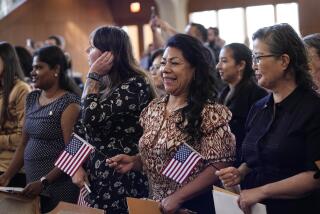9 Americans are killed by Afghan pilot
Eight U.S. troops and an American contractor were killed early Wednesday when a veteran Afghan military pilot fired on trainers during a meeting in a military compound near Kabul International Airport.
The Taliban claimed responsibility in what it said was the latest attack by an insurgent infiltrator.
The pilot opened fire about 10 a.m. after an argument with a foreign colleague at a meeting in the operations room of the Afghan air force building, according to statements released by NATO and Afghan officials. The pilot targeted foreign instructors and advisors, they said.
Afghan security forces heard the shots and surrounded the building, storming inside even as other officers leapt from the building’s second floor, said Col. Bahader, the Afghan military’s spokesman at the airport. None of the Afghan personnel died in the attack, said Bahader, who goes by one name.
Inside the building, North Atlantic Treaty Organization forces killed the attacker in a gunfight, Afghan officials said, and a NATO soldier and five Afghan air force troops were wounded. A NATO quick-reaction force responded, and coalition and Afghan officials were still investigating late Wednesday.
U.S. Army Lt. Col. Elizabeth Robbins, a Pentagon spokeswoman, confirmed that all nine foreigners killed were Americans.
The pilot, identified as Ahmad Gul Sahebi, 48, was from the Tarakhail district of Kabul province and had served in the Afghan army for decades, according to a man who claimed to be his brother.
Dr. Hassan Sahebi, a Kabul neurologist, described his brother as a dedicated soldier who was not affiliated with the Taliban or other insurgents. He said in a telephone interview that his brother had been wounded four or five times in the line of duty, and once was so severely injured in a plane crash that he underwent 22 surgeries.
“My brother was a little depressed recently, but he had served with Afghanistan’s national army for 20 years,” Sahebi said. Earlier, in a television interview, Sahebi said his brother had recently been forced to sell his home.
“He loved his country and his people,” Sahebi told The Times. “He was a good man.”
A Taliban spokesman offered a different account of the attack. He said that the shooter, whom he called Azizullah, was an insurgent from the conservative Arzan Qimat neighborhood on Kabul’s outskirts who succeeded in posing as a military pilot with help from Afghan security forces.
Spokesman Zabiullah Mujahid said Azizullah contacted Taliban leaders two years ago and had been feeding them information. He planned his attack for five months, but it wasn’t approved until Tuesday because he was a valuable source.
“The Afghan air force corps officers fully helped the suicide attacker to get in and start shooting at [Afghan] and foreign soldiers,” Mujahid said. Azizullah died when he ran out of bullets, he said.
“This attack indicates that we can access any security forces facilities of the enemy we want,” Mujahid said. “We have our infiltrators in all sections.”
The Afghan air force, formerly the Afghan national army air corps, has benefited from years of training and upgrades by U.S. forces. And it has seen rapid recruitment as officials seek to ramp up Afghan security forces to at least 305,000 members, raising fear of Taliban sleeper agents among new recruits.
The air force has grown to about 5,000 troops, Bahader said, more than doubling in size since 2008, when it inaugurated its new headquarters at the airport. The force is equipped with 26 new or refurbished aircraft, including transport helicopters and Ukrainian military planes bought with U.S. funding.
U.S. Air Force Lt. Col. David Simons, a spokesman for the coalition training mission, said the NATO Air Training Command based at the airport “has gone through numerous upgrades to secure the facilities, both on the Afghan side and the U.S. side.”
Simons said 95% of the Afghan air force’s personnel had been vetted with biometric screening, but declined to say whether the shooter also had been screened.
Afghan President Hamid Karzai ordered the Defense Ministry to investigate the shooting and other recent incidents involving insurgents posing as or infiltrating the ranks of the security forces.
Such attacks are part of a Taliban strategy to undermine the Afghan population’s faith in NATO troops and their own security forces as the U.S. prepares to begin drawing down its forces this summer, said Martine van Bijlert, co-director of the Afghanistan Analysts Network, a Kabul-based think tank.
“The image they’re portraying is, ‘We’re everywhere,’ ” she said of the Taliban. “ ‘We’re the one who are staying and we can go wherever we want.’ ”
--
molly.hennessy-fiske@latimes.com
Special correspondents Aimal Yaqubi and Hashmat Baktash contributed to this report.
More to Read
Start your day right
Sign up for Essential California for news, features and recommendations from the L.A. Times and beyond in your inbox six days a week.
You may occasionally receive promotional content from the Los Angeles Times.







